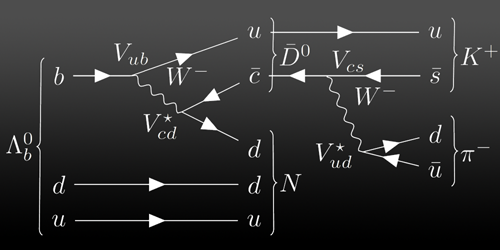Symmetry Violation Predicted for Bottom-Containing Baryon
The Universe today contains significantly more matter than antimatter. If it didn’t, we wouldn’t exist. Exactly how this imbalance came about remains a mystery. But theory suggests it relates to the violation of so-called C (charge) and P (parity) symmetries, which together require that the laws of physics are the same for a particle and for the mirror reflection of its antiparticle. Weak interactions between the quark pairs making up certain mesons are known to violate this symmetry, but those violations are not enough to explain matter’s dominance. Attempting to solve this puzzle, Yin-Fa Shen at Huazhong University of Science and Technology, China, and colleagues now predict CP symmetry breaking in a baryon, which consists of three quarks [1]. The researchers say that the experimental confirmation of their prediction would mark the first observation of CP-symmetry violation in baryonic matter, potentially pointing the way to a greater understanding of cosmic evolution.
Shen and colleagues consider the Lambda-b baryon, which comprises an up quark, a down quark, and a bottom quark. They chose this particle because theory indicates that the coupling between the up and bottom quarks has characteristics similar to those of known CP-violation cases. When the researchers modeled the decay of a Lambda-b baryon and its antiparticle—produced, for example, after the collision of a proton and an antiproton—they found a CP-symmetry violation in the form of a 10%–90% discrepancy between the two particles in the probability of a certain decay mode. Shen notes that the telltale products of these decays and their properties should be measurable in future experiments at the Large Hadron Collider at CERN, Switzerland.
–Katherine Wright
Katherine Wright is the Deputy Editor of Physics Magazine.
References
- Y.-F. Shen et al., “Possible large CP violation in charmed Λb decays,” Phys. Rev. D 108, L111901 (2023).




